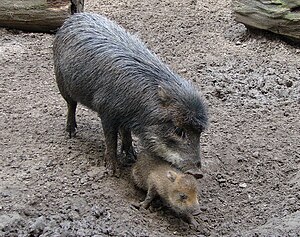Whitebeard peccary
| Whitebeard peccary | ||||||||||||
|---|---|---|---|---|---|---|---|---|---|---|---|---|

Whitebeard peccary |
||||||||||||
| Systematics | ||||||||||||
|
||||||||||||
| Scientific name of the genus | ||||||||||||
| Tayassu | ||||||||||||
| G. Fischer von Waldheim , 1814 | ||||||||||||
| Scientific name of the species | ||||||||||||
| Tayassu pecari | ||||||||||||
| ( Link , 1795) |
The Weißbartpekari ( Tayassu pecari ) is a kind of the umbilical pigs .
features

The white bearded peccary is larger and darker in color than the collar peccary and has a longer mane. The cheeks, nose and lips are white. The head body length is 90–130 cm, the shoulder height 44–60 cm and the weight 20–50 kg. Males and females are about the same size.
distribution
The distribution area extends from southern Mexico across Central America and the northeast of South America south to Argentina .
Way of life
Although the Whitebeard pekari also inhabits dry forests and savannah areas , it usually prefers the dense, tropical rainforest . It does not penetrate into arid semi-deserts like the Collared Peccary . In terms of nutrition, it is similar to the other peccaries and, like them, is an omnivore that rummages through the ground for nuts, roots and invertebrates and takes in fruits, leaves and small animals on the surface. Whitebeard peccaries defend themselves against their enemies by attacking in large numbers. Then they are considered very dangerous and even drive pumas and jaguars to flight. Nevertheless, the big cats succeed again and again in killing adult animals. Young animals also have to fear giant snakes and crocodiles. The groups of white-bearded peccaries are larger than those of the other two peccary species and can contain several hundred animals. They also roam much larger areas that can cover up to 200 square kilometers. This is possibly due to their preference for nuts and seeds, which are only temporarily found in large quantities in widely scattered places when the fruits of certain tree species are ripe. Most of the two boys are born after a gestation period of around 160 days. White bearded peccaries do not know a fixed mating season. One animal reached the age of 21 in captivity.
Existence and endangerment
Due to the large roaming areas, these animals need large undestroyed wilderness areas, which are becoming increasingly rare in their homeland today. The development of the habitats not only leads to habitat loss, but also makes it easier to hunt the animals, which is an additional threat. The whitebeard pekari was apparently wiped out 100 years ago in Uruguay, and its populations have also declined in northern Argentina. The subspecies T. p. ringens and T. p. spiradens from Central America and Northern Colombia have been displaced from most of their former range.
The White-lipped Peccary by the World Conservation Union IUCN in the Red List of endangered species out and as threatened ( Vulnerable ) rated. The reasons for this classification are the 30% decline in the population over the last 18 years, loss of habitat, illegal hunting, competition with livestock and epidemics. It is also assumed that the population will continue to shrink in the next few years.
literature
- Ronald M. Nowak: Walker's Mammals of the World . Johns Hopkins University Press, 1999, ISBN 0-8018-5789-9
Web links
Individual evidence
- ↑ Tayassu pecari in the Red List of Endangered Species of the IUCN 2013. Posted by: Keuroghlian, A., Desbiez, A., Reyna-Hurtado, R., Altrichter, M., Beck, H., Taber, A. & Fragoso, JMV, 2013. Retrieved July 10, 2013.
